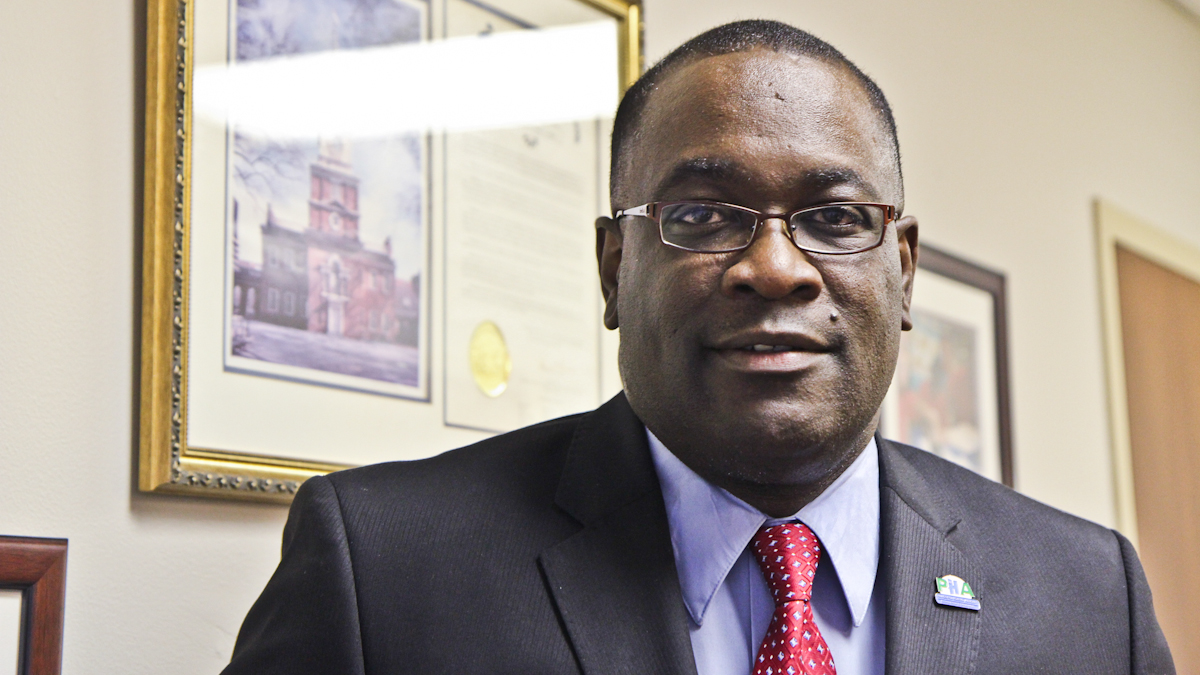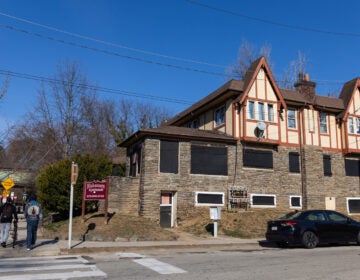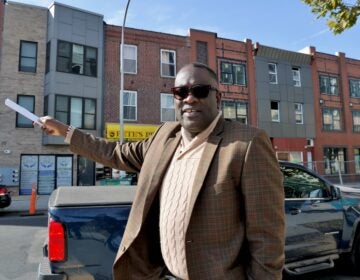On the Record: Q&A with Philadelphia Housing Authority President and CEO Kelvin Jeremiah

Twice this fall PlanPhilly’s Jake Blumgart interviewed Kelvin Jeremiah, president and CEO of the Philadelphia Housing Authority, to discuss the Authority’s current work, how it made housing vouchers available to 3,800 more households this year, its funding streams and strains, its ambitious Sharswood project, and what the recent layoff announcement means. The following is a version of these conversations, condensed and edited for clarity and length.
OCTOBER 4, 2016
PLANPHILLY: PHA recently confirmed a 14% cut in its staff. When did it become evident that layoffs of this magnitude would be required to address the budget shortfall?
KELVIN JEREMIAH: Since I’ve been here, I’ve been taking a critical look at PHA operations, the amount of federal subsidy PHA has been receiving since 2008, and it was clear to me that we had lost over $140 million in subsidies. For every dollar PHA was eligible for we were receiving 86 cents. But we were continuing to operate the agency as if none of those losses were impacting us operationally…. It became clear that one of the things we have done is use our funding flexibility to offset our deficit, which is a structural deficit. It was necessary for us to make a policy decision between serving the maximum number of families we can or provide for our administrative expenses. The decision was made to refocus on serving families and maximizing the number housed.
You are referring to the fact that under previous PHA administrators, the federal Moving to Work [MTW] designation allowed them to shift money, that otherwise would have gone to housing families, to fund the operations of the authority. So you’re saying you’ve shifted funds back to Section 8 vouchers?
Precisely. In a typical housing authority that doesn’t have Moving to Work, there are essentially three funding streams. There are the operating funds for running the housing authority, there is housing choice for running the Section 8 program, and then there is capital [for maintaining the traditional public housing program]. In a typical housing authority those three streams are isolated. You can only use capital for capital and Section 8 for Section 8 housing. Because we are MTW we have flexibility to use all those resources as we deem appropriate.
PHA reallocated some Moving to Work dollars to provide housing vouchers for 3,800 more households. When did you start moving funds back into Section 8 vouchers from the operational backend?
Two years ago. I looked at our operation and staffing level and it became clear we were staffed at higher levels than our counterparts in other cities. It became clear we could house more families – those 3,800 new families added to the Section 8 rolls. We are a housing program. Our core mission is about housing families and it is unconscionable to me to spend money that doesn’t advance the core mission of the housing authority. We could certainly use that money to have staff, but given the length of the wait, I think it’s in our interest to maximize the number of families served.
I’m sure you are aware then that there has been a lot of criticism of the Sharswood project because of how expensive it will be to build new housing and pay the prevailing wage for construction. I’ve heard critics say it would make more sense to amp up the Section 8 voucher program or repair existing housing, which would stretch the funds further and help more families.
I’ve also heard pretty clearly people saying we don’t want any more Section 8, that Section 8 is not dispersed. In this city that is a well-established fact. But I don’t believe there is any place in this city where families in need shouldn’t reside.
We are obligated under federal and state regulation to pay the prevailing wage and we have to pay it whether we are building new construction or rehab. Sometimes people don’t understand that. It is not because Kelvin Jeremiah wants to pay these incredible wage rates, it’s because we are using public money so we are obligated.
In terms of the availability of housing, we are certainly at a disadvantage in the city because there are a number of people living in poverty and we have a huge wait list. The option of not doing new development isn’t one that is in our interest. The actions we are taking in terms of the streamlining and restructuring the organization are all geared towards making sure that we are fiscally sound and increasing the availability of affordable housing.
The Blumberg/Sharswood project is incredibly ambitious and one that is badly needed in that community. I think in time people will come to understand that we are preserving affordability in an area where affordability without PHA would cease to exist. We are providing high quality homes for families in need where they can thrive in a community with the amenities we expect elsewhere.
You said the option of not doing new development wouldn’t be in PHA’s interest. What do you mean?
My point is the option of doing no new development isn’t one that is in our interest because the existing portfolio isn’t sufficient to preserve the demand that we have. We don’t have enough supply of affordable housing. If we want to address the demand, we have to increase the availability. If we are increasing the availability, we have to construct new ones.
That is not to suggest we shouldn’t be doing rehab. We have over 500 scattered-site properties that were long term vacant blighted in a lot of gentrifying communities—Temple, South Philly, Francisville, Brewerytown—we are strategically repositioning a lot of those properties. We’ve already done 600 of those, which adds to the portfolio and the tax base. I don’t think of only new construction. There is value in rehab and preservation. A few years ago there was a preservation tax credit program in Queen Lane, Queens Row, we renovated it after it was blighted for 8 to 10 years. Now we have 29 families living in those units. We continue to look for opportunities to add to the portfolio that are vacant and blighted. But doing that alone wouldn’t make a dent in the supply of affordable housing.
You are arguing it takes both rehab and new construction to meet demand, although it’s a tricky thing because there’s actually no way you could come close to meet demand at current funding levels.
That is why I attended the grand opening of St Francis Villa in East Kensington. That’s a partnership with the Catholic Archdiocese of Philadelphia, PHFA, and the city to build 44 units, a senior development. We are doing that across the city, partnering with likeminded private and nonprofit groups to build affordable housing. We have 21 such transactions underway for 2,400 units of affordable housing.
SEPTEMBER 8, 2016
The Moving to Work program is up for renewal in 2018. Housing advocates have expressed hesitancy about it in the past, noting that between 2000 and 2013 there were a lot of housing authorities that weren’t utilizing their housing choice voucher programs to the fullest extent because Moving to Work allowed them to use it in other ways. Philly in that ten-year stretch had a utilization rate of 84 percent. What are those rates currently and what else is funding being spent on?
You are correct that in the past we have had low utilization rates in our housing choice voucher program. …Those 3,800 families resulted in a significant increase in our utilization rate to 93 percent.
The other 7 percent are the funds being used for the other social service programming, job placement, job training, GED, etc. I think it is incredibly important for us to be focused in our mission driven activities to house families and appropriate dollars to do that. That’s the public policy change I made two years ago that resulted in more families being housed by the authority.
PHA’s 2016 annual report notes “Congress has underfunded the national Public Housing Operating Subsidy line item for seven of the last nine years.” A report issued in 2011 at the national level, said public housing at the national level requires $26 billion in unmet capital needs. What is the size of PHA’s unmet capital needs for its traditional public housing program?
I think the last time we assessed it was around 2011, but I’m sure it has increased over the years. It is now about $1.5 billion, and about $27 billion nationally. Our need is $1.5 billion for capital maintenance for our existing portfolio, but we only receive about $40 million. It is unlikely in the near term that we will see the level of investment in affordable housing that has been lacking for the last decade… It forces us to make some very difficult choices. We are a housing program first and foremost in a city with deep poverty, in a city with incredible demand for affordable housing. People on the waiting list have to wait 10 to 14 years because we only have about 400 units that become available annually.
How many people on the PHA’s public housing waiting list?
Nearly 40,000.
Tell me more about how PHA’s new headquarters in Sharswood is being funded. Is any of it from diversions under the Moving to Work program? If you are floating a bond, where will the interest payments come from?
The new HQ will be funded with MTW funds. We operate probably five separate offices across the city. We have two in South Philly, two in North Philly, and one in the Germantown area. We believe consolidating those into one office will save us money. The cost of operating those will be the same as debt service. We are looking at a mixture of MTW dollars as well as possible bonding, public purpose bonds—what is also referred to as capital financing from HUD for the purpose of building.
Does Moving to Work funds mean that funding is being diverted from the voucher program for the project?
There are budget lines we have for paying well over $1 million for an office on south 23rd Street—that comes from our operating budget. We’ve been planning this for over four years. We looked at options to purchase and we looked at options to build. We made a budgetary commitment to this four years ago of about $45 million, so that’s what we are doing. That’s what we budgeted for. There will be some cost saving from the consolidation and from the dispossession and releasing of some other properties we own across the city. There’s commercial property, for example the office building we own at Passyunk provides us an opportunity to sell or lease and to be able to fund the construction and debt on any property that we construct.
You’ve estimated the overall Sharswood project will cost $500 million, but that all the funding hadn’t been sorted out yet.
This is an especially delicate issue, as you can imagine. We don’t want to put out how much money is being made available because I want the market to tell us what it should be. If I tell you what amount of money is available chances are that’s the kind of bids we will get.
The first five to seven phases are already funded and that includes the office building as well as the supermarket. The subsequent phases I think we are probably about 50% there. If we continue on the current pace, I would expect the entire revitalization initiative to be fully funded in the next year or two given that it relies not just on federal appropriations but a 9 percent tax credit that we have obtained, as well as a private development activity.
Once investors see that PHA is serious about the investments it is making I would expect even more private investment activity. We’re not looking to go in alone. With the level of interest from investors, banks, and private development folks I’m confident, very confident, we’ll have all the necessary resources online to fully transform Blumberg/Sharswood.
WHYY is your source for fact-based, in-depth journalism and information. As a nonprofit organization, we rely on financial support from readers like you. Please give today.







